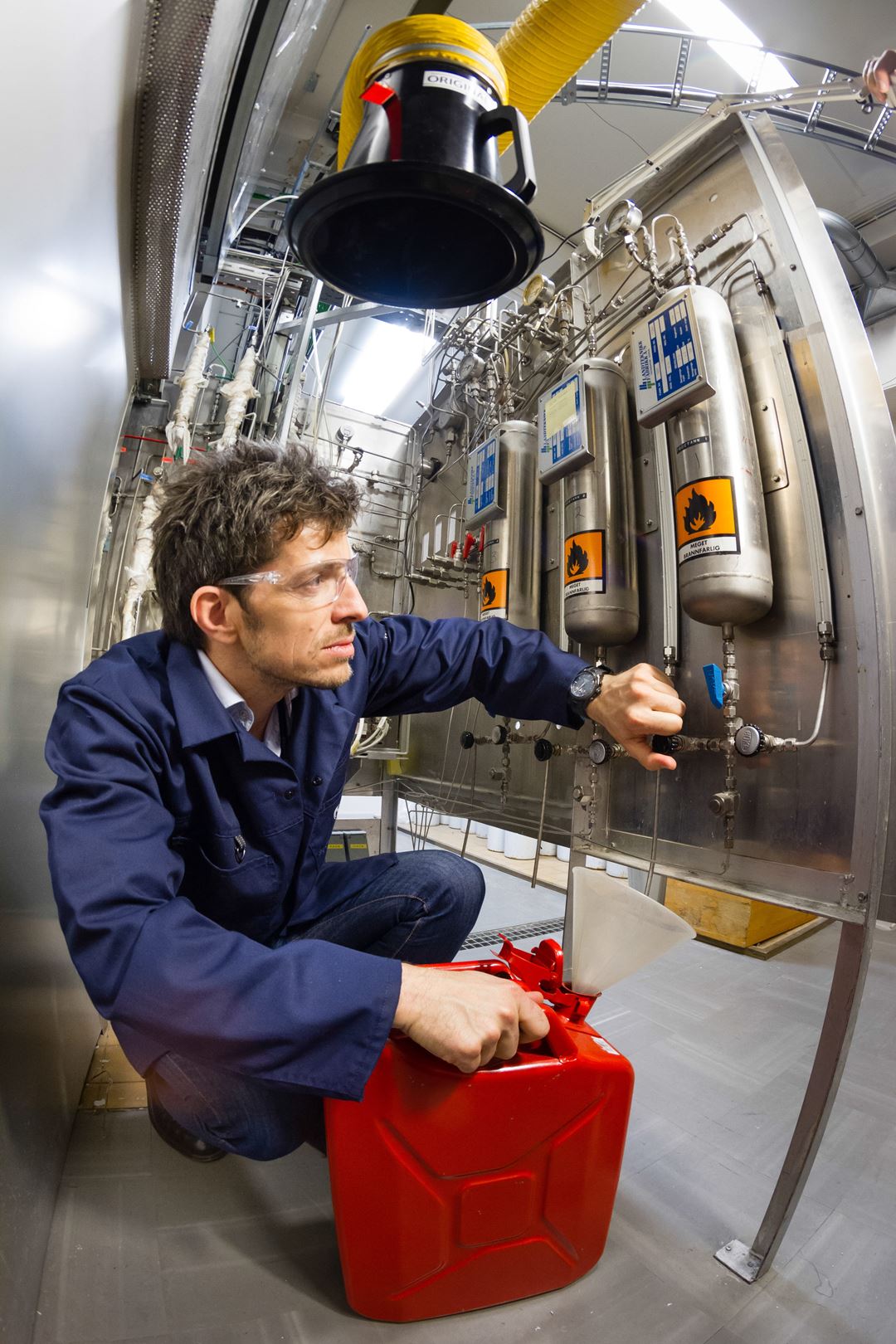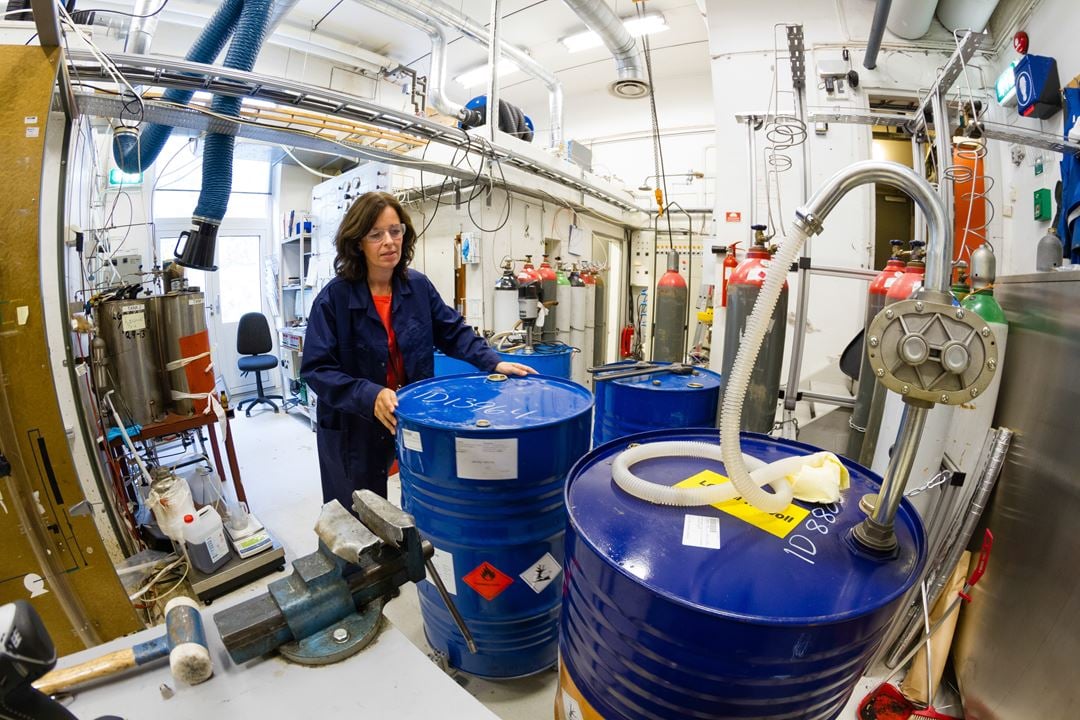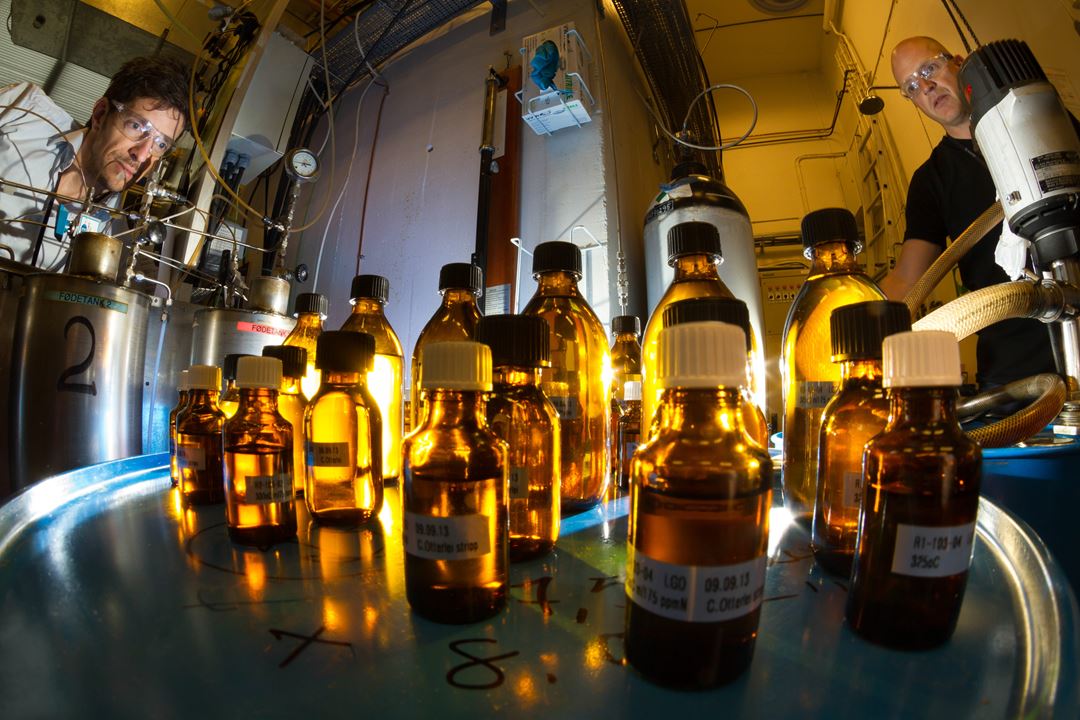Services provided:
SINTEF offers contract research for the industry related to processes for catalytic reforming and isomerization of naphtha ("Octane Processes laboratory"), and for hydroprocessing of oil fractions ("Hydroprocessing laboratory"). The objective is to identify best catalyst technology and refinery conditions.
Octane Processes laboratory
In the Octane Processes laboratory, oil fractions are processed in a pilot unit to enhance octane number and meet fuel specifications of gasoline.

Three isothermal fixed bed reactors placed in salt bath for good temperature control. Separate temperature and pressure control. Separate supply of naphtha and hydrogen.
Equipment
Fixed bed reactors
- 300 ml total volume, 50 ml catalyst
- 1" tube (di = 19,3 mm), Length 1,25 m
- Temperature: 160-530 °C
- Pressure: 0-30 bar
Flow rates
- Naphtha: 0-220 ml/h
- Hydrogen: 0-2000 ml/min
Analysis equipment
- Product distribution is measured by online GC analysis
- Water analysis by Karl-Fischer titration (METHROM 831 KF Coulometer)
- Chlorine analysis by titration
Hydroprocessing laboratory
In the Hydroprocessing laboratory, oil fractions including bio oil are processed with hydrogen in a pilot unit to meet specifications of transportation fuels.

Five isothermal fixed bed reactor units of different size. Separate temperature and pressure control. Separate supply of oil feed and hydrogen. The units are designed for continuous operation.
Equipment for destruction of produced H2S and NH3 by photo-oxidation and carbon-filtering.
Equipment
Trickle bed reactor unit
- 1000 ml total volume, 800 ml catalyst volume
- Designed for up to 500°C and 100 bar total pressure
- Verified "industrial behaviour"
Fixed bed reactor units
- Two reactors 300 ml total volume, 100 ml catalyst volume, upstream or downstream mode. Designed for 500°C and 100 bar pressure.
- Two reactors 150 ml total volume, 75 ml catalyst volume, upstream mode. Designed for 500°C and 100 bar pressure. Verified "industrial behaviour".
Analysis equipment
- Product distribution is measured by online GC analysis
- 9000 NS Nitrogen & Sulfur analyser (Antek Instruments, Inc.)
- DMA 4500 Density Meter (Anton Paar)
Read more about oil and gas conversion technology in SINTEF
References
- Steiner, P. and E.A. Blekkan, Catalytic hydrodesulfurization of a light gas oil over a NiMo catalyst: Kinetics of selected sulfur components. Fuel Processing Technology, 2002. 79(1): p. 1-12.
- Mejdell T., Myrstad R., Morud J., Rosvoll J.S., Steiner P., Blekkan E.A. A new kinetic model for hydrodesurfurization of oil products, in Studies in Surface Science and Catalysis. 2001. p. 189-194.
- Myrstad R., Rosvoll J.S., Grande K., Blekkan E.A. Hydrotreating of gas-oils: A comparison of trickle-bed and upflow fixed bed lab scale reactors, in Studies in Surface Science and Catalysis. 1997. p. 437-442.
- M. Rønning, T.G., R. Prestvik, D.G. Nicholson, A. Holmen, Influence of Pretreatment Temperature on the Bimetallic Interactions in Pt-Re/Al2O3 Reforming Catalysts Studied by X-Ray Absorbtion Spectroscopy. Journal of Catalysis, 2001. 204: p. 292-304.
- Prestvik, R., Totdal, B., Lyman, C. E., Holmen, A., Bimetallic particle formation in Pt-Re/Al2O3 reforming catalysts revealed by energy-dispersive X-ray spectrometry in the analytical electron microscope. Journal of Catalysis, 1998. 176(1): p. 246-252.
- Prestvik, R., Moljord, K., Grande, K., Holmen, A., The influence of pretreatment on the metal function of a commercial Pt-Re/Al2O3 catalyst. Journal of Catalysis, 1998. 174(2): p. 119-129.
- Gjervan, T., Prestvik, R., Tøtdal, B., Lyman, C.E., Holmen, A., The influence of the chlorine content on the bimetallic particle formation in Pt-Re/Al2O3 studied by STEM/EDX, TPR, H2 chemisorption and model reaction studies. Catalysis Today, 2001. 65: p. 163-169.
- Moljord, K., Hellenes, G.H., Hoff, A., Tanem, I., Effect of Reaction Pressure on Octane Number and Reformate and Hydrogen Yields in Catalytic Reforming. Industrial & Engineering Chemistry Research, 1996. 35(1): p. 99-105.
- Gjervan, T., Studies of Bimetallic Particle Formation in Reforming Catalysts, Doctor of Engineering Dissertation, The Norwegian University of Science and Technology, 2000
- Prestvik, R., Characterization of the metal function of a Pt-Re/Al2O3 reforming catalyst, Doctor of Engineering Dissertation, The Norwegian University of Technology, 1995
- Gjervan, T., Prestvik, R. and Holmen, A.: "Catalytic Reforming" in Basic Principles in Applied Catalysis, Baerns, M. (Ed.) (Springer, Berlin 2003) 125-158
- Prestvik, R., Moljord, K., Grande, K., and Holmen, A.: Compositional Analysis of Naphta and Reformate" in Catalytic Naphta Reforming, Antos G.J. and Aitani, A.M.(Ed.) (Marcel Dekker, New York 2003) 1-33

